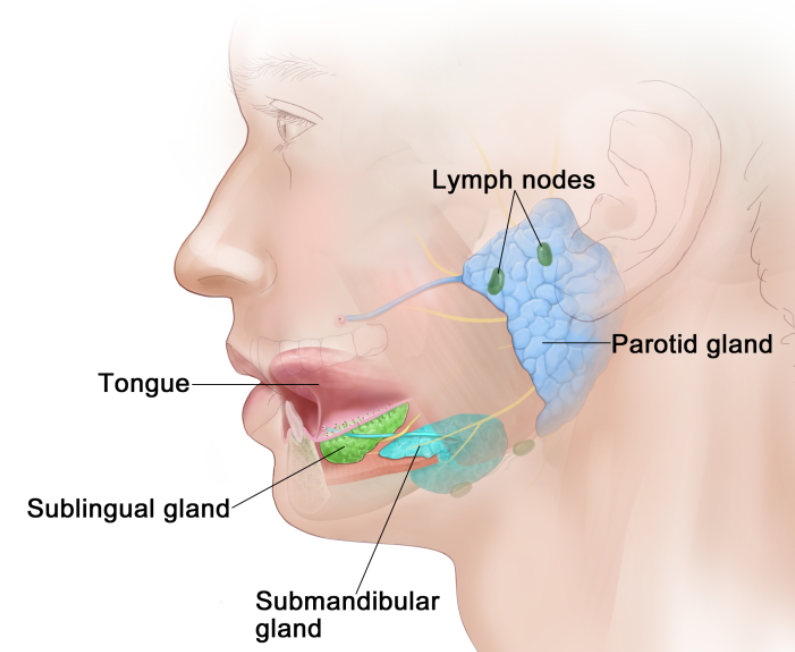
Wharton's duct is the duct of
А. Submandibular salivary gland.
B. Parotid gland.
С. Sublingual gland.
D. All of the above
Answer
566.4k+ views
Hint: The salivary gland is a type of digestive gland . Saliva is produced by the pairs of three salivary glands namely Parotids, submaxillary, sublingual gland. These glands are situated just outside the buccal cavity and they secrete salivary juice in the buccal cavity. Saliva contains salivary amylase, maltase and lysozyme.
Complete answer:
Salivary glands: Saliva is mainly produced by three pairs of salivary glands. These are:-
- Parotids: Found near the cheek and these are the largest salivary glands (opens through Stenson's duct).
- Submaxillary/Submandibular: Found at lower jaw (opens through Wharton’s duct).
- Sublinguals: Found below tongue and these are the smallest salivary glands (opens through Rivinus duct).

Now let us match these with the given options :-
> Option A: Sub mandibular salivary gland
They are also known as sub- maxillary glands. It is present below the parotid gland and above the sublingual gland. It constitutes the floor of the oral cavity. These get open through Wharton’s duct. Thus this option is correct.
> Option B: Parotid gland
These glands open through Stenson’s duct. It is the first gland. These are located in front of ears and are the largest of all salivary glands. Thus this option is not correct.
> Option C: Sublingual gland
These glands open through the Rivinus duct. It is an almond shaped gland and it is present beneath the tongue. They are 3-5% of the salivary gland. Thus this option is not correct.
Hence, the correct answer is option (A).
Note: Saliva is produced with the three pairs of salivary glands. Daily secretion of saliva is 1.5 litres, (pH of saliva is 6.7) and has salivary amylase (ptyalin), maltase and lysozyme. Salivary glands are stimulated to secrete saliva by parasympathetic innervation while sympathetic nerves cause reduced secretion leading to drying of the mouth.
Complete answer:
Salivary glands: Saliva is mainly produced by three pairs of salivary glands. These are:-
- Parotids: Found near the cheek and these are the largest salivary glands (opens through Stenson's duct).
- Submaxillary/Submandibular: Found at lower jaw (opens through Wharton’s duct).
- Sublinguals: Found below tongue and these are the smallest salivary glands (opens through Rivinus duct).

Now let us match these with the given options :-
> Option A: Sub mandibular salivary gland
They are also known as sub- maxillary glands. It is present below the parotid gland and above the sublingual gland. It constitutes the floor of the oral cavity. These get open through Wharton’s duct. Thus this option is correct.
> Option B: Parotid gland
These glands open through Stenson’s duct. It is the first gland. These are located in front of ears and are the largest of all salivary glands. Thus this option is not correct.
> Option C: Sublingual gland
These glands open through the Rivinus duct. It is an almond shaped gland and it is present beneath the tongue. They are 3-5% of the salivary gland. Thus this option is not correct.
Hence, the correct answer is option (A).
Note: Saliva is produced with the three pairs of salivary glands. Daily secretion of saliva is 1.5 litres, (pH of saliva is 6.7) and has salivary amylase (ptyalin), maltase and lysozyme. Salivary glands are stimulated to secrete saliva by parasympathetic innervation while sympathetic nerves cause reduced secretion leading to drying of the mouth.
Recently Updated Pages
Master Class 12 Business Studies: Engaging Questions & Answers for Success

Master Class 12 Economics: Engaging Questions & Answers for Success

Master Class 12 English: Engaging Questions & Answers for Success

Master Class 12 Maths: Engaging Questions & Answers for Success

Master Class 12 Social Science: Engaging Questions & Answers for Success

Master Class 12 Chemistry: Engaging Questions & Answers for Success

Trending doubts
What is meant by exothermic and endothermic reactions class 11 chemistry CBSE

Which animal has three hearts class 11 biology CBSE

10 examples of friction in our daily life

One Metric ton is equal to kg A 10000 B 1000 C 100 class 11 physics CBSE

1 Quintal is equal to a 110 kg b 10 kg c 100kg d 1000 class 11 physics CBSE

Difference Between Prokaryotic Cells and Eukaryotic Cells




